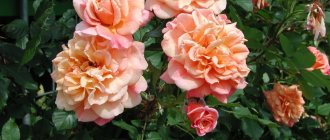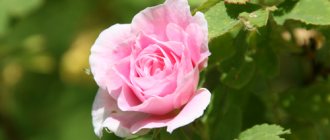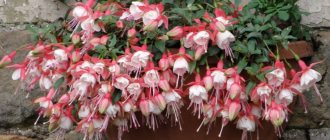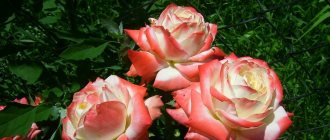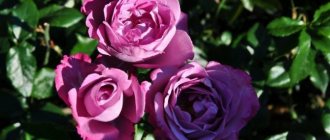Rose floribunda Rumba (Rumba) is a spectacular variety of crop, ideal for gardeners who want to create a unique landscape design in their garden. The variety is re-flowering and decorates the flowerbed in an original way with orange-yellow buds that change color as they grow. Suitable for growing in warm climates.
A distinctive feature of the Rumba rose is its double color
Description and characteristics of floribunda rose variety Rumba
Rose Rumba is a climbing, repeat-blooming and very beautiful variety of the crop, which differs from many other varieties in its compact size. Its bushes do not grow more than 180 cm in length, and do not exceed 120 cm in diameter. The lashes are well leafy. The leaf blades have a typical appearance for the crop, slightly elongated, wide at the base, and pointed towards the end. Their color is dark, emerald, with a characteristic shine. The shoots of the plant do not have thorns.
Rumba rose flowers form quite large, up to 7 cm in diameter, cup-shaped, densely double. When inflorescences bloom, they resemble brushes, each of which consists of three to five buds of unusual color. At the initial stage they are yellow in color, then the outside becomes scarlet, then dark crimson, but in the center the flower remains yellow. The variety is characterized by a delicate, unobtrusive aroma and flowering that occurs in waves.
Rose Rumba has average sensitivity to rain; blooming flowers are damaged by precipitation, but not all. The frost resistance of the crop is low, down to -20-22 °C. It is not recommended to breed it in harsh conditions. In the Urals or Siberia, the Rumba rose freezes even with careful shelter. In the Volga region, Central regions and the middle zone it grows only with careful care. Some gardeners plant it in large flowerpots and put it on a heated terrace for the winter.
The plant is drought tolerant and is not afraid of direct sunlight. There are no burns on its foliage. As for immunity, the variety has an average one. Rumba is prone to diseases common among roses and needs constant prevention.
The biological cycle of this species is long-term, the crop grows slowly, and single buds appear on it only in the third year after planting. The end point of growth occurs in the fifth year of the growing season. Rumba begins to bloom in June, the second wave occurs at the end of July, August, in September the buds bloom when grown in the subtropics.
Bloom
Rose Santana - characteristics of the variety
During the season, Rumba blooms 2 times: 1st period - end of May-June, 2nd period - July-August. The dormant period is short and not noticeable, since the flowers constantly replace each other.
Note! The withered petals of Rumba do not fall off, but dry up on the bushes. For this reason, the appearance of the plant becomes untidy, and flowering weakens. Therefore, gardeners must remove faded inflorescences in a timely manner.
Lack of flowers
In the first year of bush development, this is normal for Rumba. Otherwise, you need to establish the cause and solve the problem:
| Cause | Solution |
| Poor landing site (little sun, many drafts) | Replant the bush, remove the shadow |
| Depleted soil | Apply fertilizer |
| Trimming the bush too short | Allow the bush to develop |
Advantages and disadvantages of the variety
Despite the abundance of positive characteristics, the Rumba rose has a number of negative features.
The variety is unable to grow in cold regions
Advantages:
- unusual color of buds;
- pronounced aroma;
- correct shape of flowers;
- absence of thorns;
- resistance to burnout;
- re-blooming;
- universal use.
Flaws:
- sensitivity to rainy weather;
- susceptibility to disease;
- demands on watering;
- intolerance to low temperatures.
Reproduction methods
Since the Rumba rose was obtained by crossing several varieties of flowers, it cannot be obtained from seeds. Reproduction is carried out only by cuttings and layering.
The first method is more effective; it allows the young plant to take root well and take root. To carry out the procedure, before the rose budding or at the end of the first wave of flowering, cut off the vine of last year's shoot, divide it into parts of 12 cm, so that each has 2-3 leaves, make an even cut at the top, at an angle at the bottom. Each cutting is treated with an antifungal drug, placed in the ground 5 cm deep, and a greenhouse is built over the planting material.
Important! During the process of rooting Rumba cuttings, they should be provided with proper care: moisture, air circulation.
For the winter, young rose shoots are well covered. With the arrival of warmer weather, they are transplanted to a permanent place.
Flowering of a crop grown from cuttings can be observed after two years
Reproduction of the Rumba rose by layering does not give such good results, since even with a slight drop in temperature or a slight lack of moisture, the plant dies. This method is usually used by gardeners living in areas with warm climates without sudden weather changes.
Planting and caring for floribunda rose Rumba
Growing the Rumba grandiflora rose is not a difficult process only if it grows in favorable conditions. When there is instability in the temperature regime, the process of caring for the crop becomes more complicated.
Comment! Rose Rumba is quite demanding when it comes to watering and fertilizing, and is capricious to some external factors.
Conditions and terms of landing
Before planting, you should select a site. It should be well lit and protected from wind and draft. If this rule is not followed, the Rumba rose bush will often get sick, and its flowers will become smaller, fade and fall off immediately after blooming.
The soil for the crop should allow moisture and air to pass through well and be loose. It is better if it is loam or sandstone.
Rumba is usually planted in the spring, in a place prepared in advance. Autumn planting is also possible, but provided that cold weather does not set in for at least another month.
Attention! In September, the plant is planted in a hole prepared in the spring.
How to plant correctly
At least four months before planting a rose of the Rumba variety, the area under it is dug up, at least 5 kg of compost, 30 g of potassium salt and superphosphate are added to the soil, and lime is added. Before planting a seedling, dig a hole 20 cm deeper than its roots. Next, a layer of drainage and fertile soil is poured into it, a mound is made on which the root system of the plant is placed. Pour some soil into the hole, water it to the brim, fill it completely with soil and moisten it again. You can place mulch on top of the soil.
Important! The root neck of the Rumba rose is deepened by 5 cm.
Since the plant needs support, after planting the seedling, a trellis up to 150 cm in height or another structure is inserted near it, on which the pink lashes will be attached during the growth process.
Comment! After just three days, it is recommended to treat the roses against diseases.
Aftercare
In order for the Rumba rose to feel good in the flowerbed, bloom profusely and develop, it needs to be properly cared for.
The main thing the plant needs is abundant moisture without stagnation of moisture. The top layer of soil should always be damp. After watering, the soil must be loosened and weeds must be removed at the same time. It is allowed to mulch the tree trunk circles of the plant.
During the Rumba planting season, there is no need to fertilize it, but in subsequent years, fertilizing is required. The drugs are applied three times a year:
- in early spring - potassium and nitrogen;
- in summer - phosphates;
- at the time of preparation for winter - phosphorus-potassium compounds and minerals.
In spring and autumn, the Rumba rose variety needs pruning and shaping of the bush. In April, frozen, damaged shoots and branches growing inward are removed. At the end of September, weak and non-lignified parts of the plant are cut off.
Comment! At the moment of flowering of the crop, all wilted buds are removed from it.
With the beginning of leaf fall, Rumba floribunda bushes are prepared for wintering. Each one is watered, the water consumption should be two buckets per plant, humus is added (layer 20 cm), fertilizers, and hilling is carried out. In October, the rose lashes are removed from the support, bent to the ground and pinned. A layer of fallen leaves, straw, sawdust is poured on top of the bush, and covered with agrofibre and spruce branches.
In winter, it is advisable to cover the Rumba rose bushes with snow.
What else should you pay attention to?
Mikhail Vostroknutov, designer
Parking space: if you don’t immediately leave room for 2-4 cars, you and your guests will face difficulties and inconveniences in the future. Space for snow: think in advance where you will throw the snow from the paths and parking space in the winter so that you don’t have to remove it with a wheelbarrow or throw it over the fence. Plantings along the roof slope: planting trees and creating paths is done in the summer. But if the plantings and paths are under the slope of the roof of the house, in winter all this will be broken by the falling snow.
The windows of the house are opposite: if you like to show yourself and look at others, you can place the windows opposite the neighbors. In all other cases, a blank wall facing the neighbor's house will be a more correct solution. Paths: when arranging paths on the site, you cannot rush at all! Use the old rule: just wait for people to make their own paths where they find it most comfortable to walk. Only after this can paths be laid on top of the trampled paths.
Read also: Whose head did the apple fall on?
Diseases and pests
Floribunda rose Rumba does not have strong immunity and requires regular preventive maintenance - spraying with copper sulfate or Bordeaux mixture. It can often be affected by black spot and powdery mildew.
Throughout the summer, the Rumba rose is constantly attacked by aphids.
The bushes should be periodically inspected for the presence of pests and treated with special means.
Advice! If there are few insects, then get rid of them with an infusion made from garlic or a soap solution.
Application in landscape design
Thanks to the beautiful color of the buds, abundant and long flowering, the Rumba rose variety is quite popular among gardeners and landscape designers. This climbing (climbing) variety looks great as a vertical landscaping plant for gazebos, terraces, and arched structures. Quite often, verandas and unattractive walls of buildings are decorated with shrubs. Due to the lack of thorns, the Rumba rose is suitable for creating borders. The variety looks great in single plantings.
When planted in group compositions, due to the tall vines, the Rumba rose is often given a place in the background.
Use Cases
Rumba looks great both planted as a single bush and in groups. The absence of thorns on the shoots of the crop allows it to be placed in borders on the sides of garden paths. It can be included in mixed compositions with other annual and perennial plants, and other varieties of low-growing roses. The beauty is suitable for placement in flowerbeds of various shapes and types, including classic round flowerbeds, mixborders and borders. The tenderness and sophistication of the charming shrub will be emphasized by ornamental cereals and fragrant flowering herbs. Conifers will also be good companions for Rumba. For example, a composition consisting of compact rose bushes and evergreen “balls” of boxwood looks very beautiful. A successful combination is the combination of floribunda with plants that have small flowers: verbena, bells, daisies. The buds of this variety last a long time in water. They make delightful flower bouquets and baskets.

